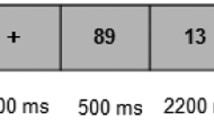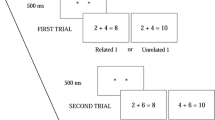Abstract
It is well known that people use several strategies to accomplish most cognitive tasks. Unknown is whether they can combine two strategies. The present study found that such strategy combination can occur and improves participants’ performance. Participants verified complex multiplication problems that violated the five rule (5 × 32 = 164), parity rule (5 × 12 = 65), both parity and five rules (5 × 31 = 158), or no rule (5 × 26 = 140). Participants obtained better performance on problems violating both five and parity rules than on problems violating either (or no) rule. Moreover, we found event-related potential (ERP) differences between two-rule and one-rule violation problems between 550 ms and 850 ms post-stimulus presentation, and ERP differences between parity-rule and five-rule violation problems between 850 ms and 1,400 ms. These findings have important implications to further our understanding of strategic variations in human cognition and suggest that strategy combination may occur in a wide variety of cognitive domains.





Similar content being viewed by others
References
Ashcraft, M. H., & Battaglia, J. (1978). Cognitive arithmetic: Evidence for retrieval and decision processes in mental addition. Journal of Experimental Psychology: Human Memory and Learning, 4, 527–538.
Campbell, J. I. D. (2005). Handbook of mathematical cognition. New York: Psychology Press.
Carpenter, P. A., Just, M. A., & Reichle, E. D. (2000). Working memory and executive functions: Evidence from neuroimaging. Current Opinion in Neurobiology, 10, 195–199.
Dehaene, S., Spelke, E., Pinel, P., Stanescu, R., & Tsivkin, S. (1999). Sources of mathematical thinking: Behavioral and brain-imaging evidence. Science, 284, 970–974.
Delorme, A., & Makeig, S. (2004). EEGLAB: An open source toolbox for analysis of single-trial EEG dynamics including independent component analysis. Journal of Neuroscience Methods, 134(1), 9–21.
Dunlosky, J., & Hertzog, C. (2001). Measuring strategy production during associative learning: The relative utility of concurrent versus retrospective reports. Memory & Cognition, 29(2), 247–253.
El Yagoubi, R. E., Lemaire, P., & Besson, M. (2003). Different brain mechanisms mediate two strategies in arithmetic: Evidence from event-related brain potentials. Neuropsychologia, 41(7), 855–862.
Galfano, G., Mazza, V., Angrilli, A., & Umiltà, C. (2004). Electrophysiological correlates of stimulus-driven multiplication facts retrieval. Neuropsychologia, 42(10), 1370–1382.
Geary, D. C. (1994). Children's mathematical development. Washington, DC: American Psychological Association.
Grabner, R. H., & De Smedt, B. (2011). Neurophysiological evidence for the validity of verbal strategy reports in mental arithmetic. Biological psychology, 87, 128–136.
Johnson, M. M. S. (1990). Age difference in decision making: A process methodology for examining strategic information processing. Journal of Gerontology, 45(2), 75–78.
Kane, M. J., & Engle, R. W. (2002). The role of prefrontal cortex in working-memory capacity, executive attention, and general fluid intelligence: An individual-differences perspective. Psychonomic Bulletin & Review, 9(4), 637–671.
Kiefer, M., & Dehaene, S. (1997). The time course of parietal activation in single-digit multiplication: Evidence from event-related potentials. Mathematical Cognition, 3, 1–30.
Krueger, L. E. (1986). Why 2 × 2 = 5 looks so wrong: On the odd-even rule in product verification. Memory & Cognition, 14, 141–149.
Lemaire, P., & Fayol, M. (1995). When plausibility judgements supersed fact retrieval: The example of odd-even effect in product verification. Memory & Cognition, 23, 34–48.
Lemaire, P., & Reder, L. (1999). What affects strategy selection in arithmetic? The example of parity and five effects on product verification. Memory and Cognition, 22, 364–382.
Lemaire, P., & Siegler, R. S. (1995). Four aspects of strategic change: Contributions to children's learning of multiplication. Journal of Experimental Psychology: General, 124, 83–97.
Lovett, M. C., & Anderson, J. R. (1996). History of success and current context in problem solving: Combined influences on operator selection. Cognitive Psychology, 31, 168–217.
Lovett, M. C., & Schunn, C. D. (1999). Task representations, strategy variability, and base-rate neglect. Journal of Experimental Psychology: General, 128(2), 107–130.
Masse, C., & Lemaire, P. (2001). Do people combine the parity- and five-rule checking strategies in product verification? Psychological Research, 65, 28–33.
Menon, V., Rivera, S. M., White, C. D., Glover, G. H., & Reiss, A. L. (2000). Dissociating prefrontal and parietal cortex activation during arithmetic processing. NeuroImage, 12, 357–365.
Niedeggen, M., Rösler, F., & Jost, K. (1999). Processing of incongruous mental calculation problems: Evidence for an arithmetic N400 effect. Psychophysiology, 36, 307–324.
Payne, J. W., Bettman, J. R., & Johnson, E. (1993). The adaptive decision maker. New York: Cambridge University Press.
Rieskamp, J., & Otto, P. E. (2006). SSL: A theory of how people learn to select strategies. Journal of Experimental Psychology: General, 135(2), 207–236.
Siegler, R. S. (1988). Strategy choice procedures and the development of multiplication skills. Journal of Experimental Psychology: General, 117, 258–275.
Siegler, R. S., & Araya, R. (2005). A computational model of conscious and unconscious strategy discovery. In R. V. Kail (Ed.), Advances in child development and behaviour (pp. 1–42). Oxford: Elsevier.
Siegler, R. S. (2007). Cognitive variability. Developmental Science, 10, 104–109.
Stanescu-Cosson, R., Pinel, P., Van de Moortele, P.-F., Le Bihan, D., Cohen, L., & Dehaene, S. (2000). Understanding dissociations in dyscalculia: A brain imaging study of the impact of number size on the cerebral networks for exact and approximate calculation. Brain, 123, 2240–2255.
Uittenhove, K., Poletti, C., Dufau, S., & Lemaire, P. (2013). The time course of strategy sequential difficulty effects: An ERP study in arithmetic. Experimental Brain Research, 227(1), 1–8.
Zago, L., & Tzourio-Mazoyer, N. (2002). Distinguishing visuospatial working memory and complex mental calculation areas within the parietal lobes. Neuroscience Letters, 331, 45–49.
Author information
Authors and Affiliations
Corresponding author
Appendix
Appendix
List of stimuli
Rights and permissions
About this article
Cite this article
Hinault, T., Dufau, S. & Lemaire, P. Strategy combination in human cognition: a behavioral and ERP study in arithmetic. Psychon Bull Rev 22, 190–199 (2015). https://doi.org/10.3758/s13423-014-0656-8
Published:
Issue Date:
DOI: https://doi.org/10.3758/s13423-014-0656-8




